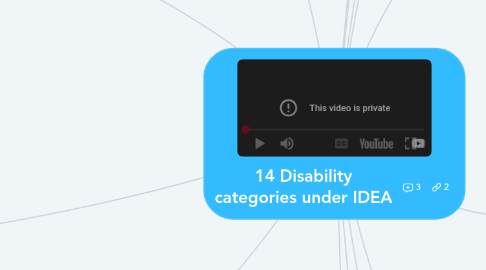
1. speech and language impairment (high incidence)
1.1. This is a communication disorder like stuttering impaired articulation, language or voice impairment that adversely affects learning of students.
1.1.1. Assistive Technology
1.1.1.1. speech recognition software
1.1.2. Intervention and modification
1.1.2.1. Individualized education program
1.1.2.2. speech language therapy
1.1.2.3. functional and practical work
1.1.2.4. peer buddy system
1.1.2.5. use of gesture
1.1.2.6. augmentative communication system
2. specific learning disabilities (high incidence)
2.1. This is a disorder in one or more of the basic psychological process involved in understanding or using language, spoken or written and affects learning of students
2.1.1. Assistive Technology
2.1.1.1. electronic dictionary
2.1.1.2. free open source software
2.1.1.3. open education resources
2.1.2. Intervention and modification
2.1.2.1. skill building strategy
2.1.2.2. Individual Education Program
2.1.2.3. academic or behavior intervention
2.1.2.4. lowering the level of learning material
2.1.2.5. collaboration between the nurse, teacher and parents
3. Emotional disturbance (high incidence)
3.1. Inability of student to maintain good relationship between peers or teacher and exhibit inappropriate behavior under normal circumstances which could be as a result of anxiety or depression.
3.1.1. Assistive Technology
3.1.1.1. free and open source software
3.1.1.2. open educational resources
3.1.2. Intervention and modifications
3.1.2.1. corporate learning activities
3.1.2.2. social skills
3.1.2.3. behavior intervention plan
3.1.2.4. physical therapy
3.1.2.5. visual support and visual schedules
3.1.2.6. self awareness and self control
4. Intellectual disability (high incidence)
4.1. Is a significantly subaverage general intellectual functioning, it exists concurrently with deficits in adaptive behavior and is manifested during development period
4.1.1. Assistive Technology
4.1.1.1. adaptive/alternative input device
4.1.1.2. literacy software design (audio and video)
4.1.2. Intervention and modifications
4.1.2.1. social skills
4.1.2.2. functional communication system
4.1.2.3. behavior management technique
4.1.2.4. student teacher ratio
4.1.2.5. give students more time to finish their work
5. Multiple disabiliities (low incidence)
5.1. This is a combination of different impairment, and more concomitant impairment
5.1.1. Assistive Technology
5.1.1.1. open education resource
5.1.1.2. audio and video apps
5.1.1.3. apps on mobile device
5.1.2. Intervention and modifications
5.1.2.1. individual education programes
5.1.2.2. collaborative practice
5.1.2.3. individualized curriculum
5.1.2.4. effective communication
5.1.2.5. academic or behavior intervention
5.1.2.6. multiple sensory technique
5.1.2.7. mini lesson skill deficit
6. deaf-blindness (low incidence)
6.1. Concomitant hearing and visual impairment which might be as a result of down syndrome or multiple congenital anomalies
6.1.1. Assistive Technology
6.1.1.1. braille translation software
6.1.1.2. screen enlargement software
6.1.1.3. screen reader
6.1.2. Intervention and modifications
6.1.2.1. group work technique
6.1.2.2. give student extra time to finish work
6.1.2.3. symbol communication system
7. Deafness (low incidence)
7.1. A situation where a child is totally deaf and cannot hear
7.1.1. Assistive Technology
7.1.1.1. eye tracking software
7.1.1.2. captioned media programs
7.1.1.3. Tv captioned
7.1.2. Intervention and modification
7.1.2.1. clearly enunciate speech
7.1.2.2. educational interpreter ( signed English
7.1.2.3. give student extra time to finish work
8. hearing impairment low incidence)
8.1. This is a situation where student is not totally deaf but have an impairment in hearing, they have a reduction in hearing
8.1.1. Assistive Technology
8.1.1.1. closed captioning software
8.1.2. Intervention and modifications
8.1.2.1. visual aid therapy
8.1.2.2. physical accommodation
8.1.2.3. sign interpreters and captionists
9. Autism (low incidence)
9.1. A developmental disability significantly affecting verbal and non verbal communication and social interaction of a child
9.1.1. Assistive Technology
9.1.1.1. visual representation system
9.1.2. Intervention and modifications
9.1.2.1. speech language therapy
9.1.2.2. physical therapy
9.1.2.3. sensory integration therapy
9.1.2.4. occupational therapy
10. Orthopedic impairment (low incidence)
10.1. Impairment caused by a congenital anomaly or by disease like poliomyelitis or from other cause like amputations, fracture or burn that cause contracture, it involves physical disability which affects the academics of a child
10.1.1. Assistive Technology
10.1.1.1. speech recognition software
10.1.1.2. screen reading software
10.1.1.3. academic software package
10.1.1.4. augmentative and alternative communication device
10.1.1.5. motion-based alternative text
10.1.2. Intervention and modification
10.1.2.1. inclusive classroom
10.1.2.2. modified writing aids
10.1.2.3. specialized exercise equipment
10.1.2.4. special chairs and table for proper posture
11. Other health impairment ( low incidence)
11.1. These comprise range of conditions which could limit the strength, alertness or vitality of students and can be cause as a result of chronic ar acute health problems like asthma sickle cell anaemia, leukaemia.
11.1.1. Assistive Technology
11.1.1.1. free Ebook
11.1.1.2. free and open source software
11.1.2. Intervention and modification
11.1.2.1. individual education program
11.1.2.2. collaboration between nurse, parent and teacher
11.1.2.3. restructure curriculum
12. Traumatic brain injury ( low incidence)
12.1. This is an injury to the brain caused by external physical force resulting to total or partial functional disability, sometimes results to lost of memory.
12.1.1. Assistive Technology
12.1.1.1. electronic dictionary/thesauns
12.1.1.2. free and open source software
12.1.1.3. tapr recorders
12.1.2. Intervention and modifications
12.1.2.1. use of pictures and icons
12.1.2.2. visual display
12.1.2.3. physical therapy
12.1.2.4. self management and self monitoring strategies
12.1.2.5. reinforcement
12.1.2.6. multiple choice technique
13. Developmental delay (low incidence)
13.1. When a child is expected to display some behaviors due for their age and those signs are lacking, there is development delay in physical, cognitive, communication,social or emotional which affects the academic success of such child
13.1.1. Assistive Technology
13.1.1.1. adaptive/alternative input device
13.1.1.2. pencil grips
13.1.1.3. augmentative and alternative communication
13.1.1.4. picture exchange communication system
13.1.2. Intervention and modification
13.1.2.1. social stories
13.1.2.2. physical therapy
13.1.2.3. give student more time to finish work
13.1.2.4. social skills
13.1.2.5. self care skills
13.1.2.6. speech language therapy
13.1.2.7. occupational therapy
13.1.2.8. visual schedules
14. Visual Impairment (including blindness) its a low incedence
14.1. This is a kind of vision loss and a decreased ability to see to a degree that causes problems not fixable by usual means
14.1.1. Assistive Technology
14.1.1.1. braille display
14.1.1.2. screen recognition software
14.1.1.3. speech access software
14.1.2. Intervention and modification
14.1.2.1. physical education
14.1.2.2. oral instruction
14.1.2.3. physical activities
14.1.2.4. give more time to finish work
14.1.2.5. use of manipulatives
